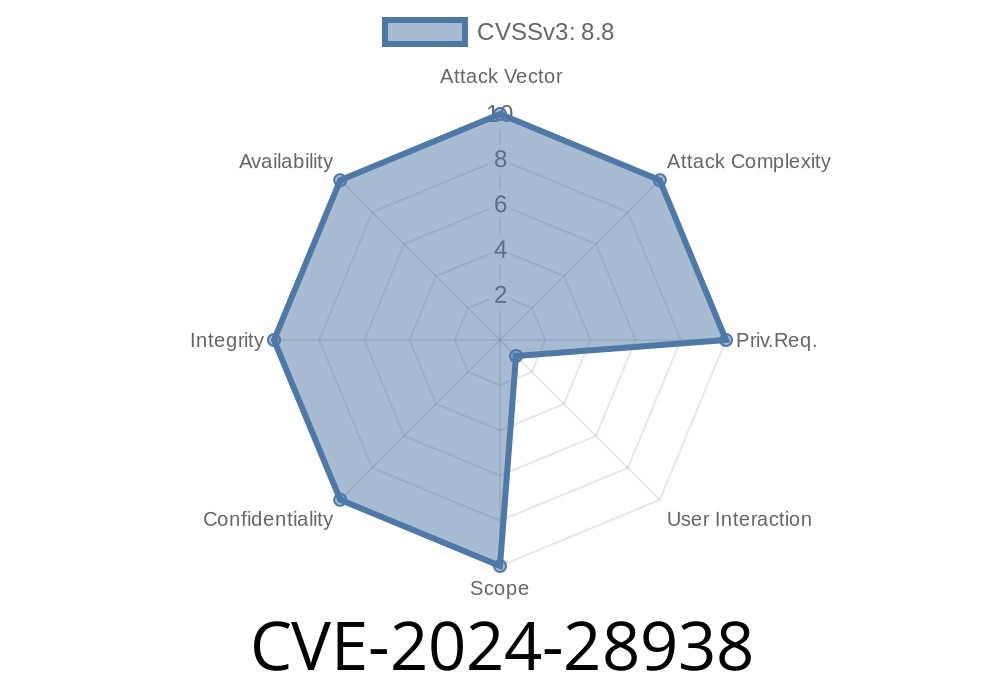A recent vulnerability, CVE-2024-28938, was discovered to affect the Microsoft ODBC Driver for SQL Server, enabling attackers to perform remote code execution. This blog post will provide an in-depth analysis of this critical security vulnerability, including a code snippet, links to original references, and details on how the exploit functions. It is essential for users and administrators alike to understand the risks involved and apply security patches immediately.
Background
The Microsoft ODBC (Open DataBase Connectivity) Driver for SQL Server is widely used by many applications to communicate with SQL Server databases. It provides a standardized API that allows developers to create and manage connections to Microsoft SQL Server and perform various data operations.
Vulnerability Details
The vulnerability lies in incorrect handling of certain parameters during the connection establishment process to a remote SQL Server. An attacker who exploits this vulnerability can execute malicious code remotely, potentially taking full control of the target system.
Modify, delete, or even create new data on the target system
The vulnerability is exploitable only if the attacker can send a specially crafted request to the ODBC driver while establishing a connection to a SQL Server database. This can primarily be achieved by directly targeting vulnerable applications that use the ODBC driver or via social engineering.
Proof of Concept (PoC) Code Snippet
The code snippet below demonstrates how a malformed ODBC connection string can be used to trigger the vulnerability (please note that this code is for educational purposes only and should not be used to exploit real systems):
#include <iostream>
#include <Windows.h>
#include <sqlext.h>
int main()
{
SQLHENV hEnv;
SQLHDBC hDbc;
SQLRETURN retcode;
SQLAllocHandle(SQL_HANDLE_ENV, SQL_NULL_HANDLE, &hEnv);
SQLSetEnvAttr(hEnv, SQL_ATTR_ODBC_VERSION, (SQLPOINTER)SQL_OV_ODBC3, );
SQLAllocHandle(SQL_HANDLE_DBC, hEnv, &hDbc);
// Exploit occurs when passing a malicious connection string
std::string malicious_connection_string = "UID=admin;PWD=pass;SERVER=example.com;DATABASE=test;";
malicious_connection_string += "Some_Malicious_Payload_Here";
retcode = SQLDriverConnect(hDbc, ,
(SQLCHAR*)malicious_connection_string.c_str(),
SQL_NTS, NULL, , NULL, SQL_DRIVER_NOPROMPT);
if (retcode != SQL_SUCCESS_WITH_INFO)
{
std::cerr << "Error occured while connecting!" << std::endl;
}
SQLDisconnect(hDbc);
SQLFreeHandle(SQL_HANDLE_DBC, hDbc);
}
Original References
1. CVE Record: https://cve.mitre.org/cgi-bin/cvename.cgi?name=CVE-2024-28938
2. Microsoft Security Advisory: https://portal.msrc.microsoft.com/en-US/security-guidance/advisory/CVE-2024-28938
3. National Vulnerability Database: https://nvd.nist.gov/vuln/detail/CVE-2024-28938
Mitigations
Microsoft has released security patches addressing the vulnerability in the affected versions of the ODBC Driver for SQL Server. It is crucial for users and administrators to apply the appropriate patch as soon as possible to protect against potential exploitation.
Conclusion
The CVE-2024-28938 vulnerability in Microsoft ODBC Driver for SQL Server is a serious security threat with the potential to lead to remote code execution and unauthorized access to sensitive information. It is essential to stay informed, prioritize patch management, and implement additional security measures to mitigate potential risks effectively.
Timeline
Published on: 04/09/2024 17:15:55 UTC
Last modified on: 04/10/2024 13:24:00 UTC
